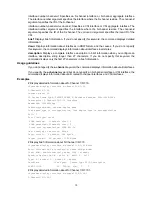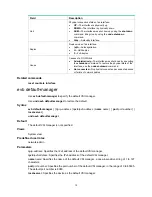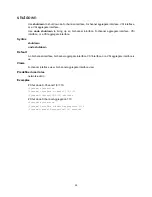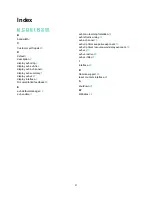
21
Usage guidelines
Configurations such as traffic monitoring on a VSI interface or VSI aggregate interface take effect
only after the VSI interface or VSI aggregate interface is activated. When a VSI interface or VSI
aggregate interface is not activated, do not make any configurations other than filters on the either
interface. For more information about traffic monitoring, see
ACL and QoS Configuration Guide
.
Activate a VSI interface or VSI aggregate interface after configuring a VSI filter, and deactivate a VSI
interface or VSI aggregate interface before removing a VSI filter.
Examples
# Activate S-Channel 1/0/1:10.1.
<Sysname> system-view
[Sysname] interface s-channel 1/0/1:10.1
[Sysname–S-Channel1/0/1:10.1] evb vsi active
# Activate Schannel-Aggregation 1:10.1.
<Sysname> system-view
[Sysname] interface schannel-aggregation 1:10.1
[Sysname–Schannel-Aggregation1:10.1] evb vsi active
Related commands
evb vsi filter
evb vsi filter
Use
evb vsi filter
to configure a VSI filter.
Use
undo evb vsi filter
to remove a VSI filter.
Syntax
evb vsi filter
[
group
group-id
]
vlan
vlan-id
[
mac
mac-address
]
undo evb vsi filter
[
group
group-id
] [
vlan vlan-id
[
mac
mac-address
] ]
Default
No VSI filter exists.
Views
VSI interface view, VSI aggregate interface view
Predefined user roles
network-admin
Parameters
group
group-id
: Specifies a group ID that classifies VLAN IDs, in the range of 1 to 4094. When the
number of VLANs exceeds 4094, the group ID and VLAN ID together identify a VLAN.
vlan
vlan-id
: Specifies the VLAN ID in the range of 1 to 4094. The VLAN must exist.
mac
mac-address
: Specifies the MAC address, which must be a valid unicast MAC address.
Usage guidelines
The EVB bridge uses a VSI filter to identify VSI traffic for a VM. Filters are usually assigned by a VSI
manager. You can also manually create or remove a VSI filter by executing this command.
A VSI filter contains a set of VID values, MAC addresses, and group ID values. EVB supports the
following filter info formats:
•
VLAN ID











































